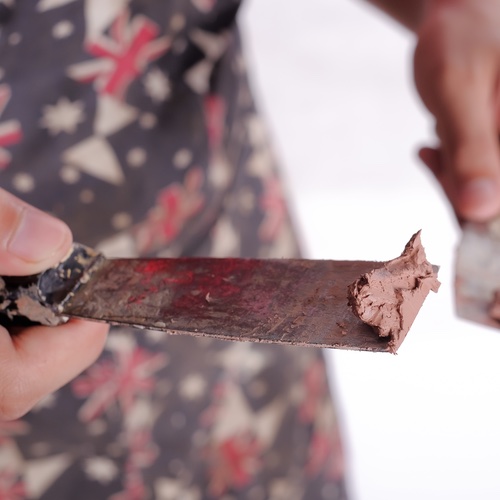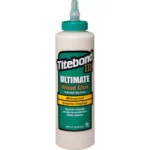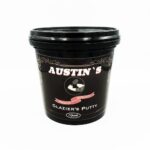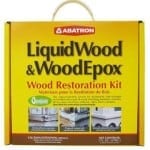
Having worked in the restorations trades for more than 20 years I have constantly been on the search for the best wood filler. I have tried countless products that at first seemed like a winner only to find, just like my high school dating experiences, they wouldn’t go the distance.
The conclusion I have come to is that there isn’t just one product, but rather a group of products that can handle any wood patching task I need. The best wood filler is sometimes not a wood filler at all, but a wood epoxy or even a putty. In this post, I’ll give you my take on the best products to patch wood on the market today.
The first thing you need to consider when choosing the best wood filler is what its use will be. Is it outdoors or indoors, painted or varnished, structural or cosmetic? There is a product for any need listed below, and you’ve just got to find the right one from the list below.
You can also read the results of my 5-year field testing of most of these wood fillers and epoxies at The Wood Filler & Epoxy Test (Year 5) to see how these products performed in the real world as well as to watch the video below.
MH Ready Patch
Best for small cosmetic repairs and surface leveling – MH Ready Patch is a great patch for a myriad of little patches. It doesn’t work for structural patches like an epoxy, but it does work quite well for things like nail holes and surface imperfections in painted wood (it’s not stainable). It dries fast, 30-45 mins and it’s ready to sand.
It is an oil-based product, but it cleans up with soap and water, which I love. I use it to fill holes smaller than a dime in size, smooth out alligatoring paint, surface checks, fill surface gouges or almost anything else I may need. Its only weakness is when you try to fill large areas which causes it to sag and shrink. Keep it limited to very small areas and always make sure you paint it because it will not last if left exposed to the elements.
LiquidWood & WoodEpox
Best for structural repairs or rebuilding of big portions of wood – There are tons of different types of epoxies for wood, but this product is by far my favorite because of its ease of use and long performance.
We use this every single day and my rot repair franchise Preservan uses a similar product by the truckload. The two parts work together to stabilize “punky” wood and fill in the missing areas.
The repairs can be sanded, drilled, planed, and essentially you are left with a repair that performs just like wood but will never rot or fall out. Epoxy repairs are some of the strongest, most long-lasting ways to patch wood. They are structural, so they can be used anywhere and are usually not troubled by water issues like other wood fillers.
Got some serious rot? This is the stuff you need. For info on how to use this awesome product, read my tutorial How To Repair Rotted Wood With Abatron Epoxy.
KwikWood
Best for small structural repairs in a hurry – Anyone who occasionally needs to patch wood should have a tube of this sitting in their shop or garage. This is a very simple to use 2-part epoxy that you mix with your hands. It’s kind of like squishing a tootsie roll together to mix both parts. Once you mix it, you have about 10 minutes before it starts to set up, and in 20-30 mins it is hard as a rock.
I use it to fill screw holes that have stripped out so I can get a sagging door hung again quickly or other tasks like that. Its fast drying time and resistance to rot and mildew make it perfect for exterior repairs too. I have used it outdoors and left it unpainted for years (not on purpose) with no problem.
Minwax Wood Filler
Best all-purpose wood filler – You knew I’d get around to an actual wood filler soon, right? Minwax Wood filler is such an easy to use and great product I am constantly surprised by how good it does for how little it costs. In the video above you can see the incredible results I got after a 5 year test with this stuff. It outperformed some epoxies and more expensive products big time.
It’s simple to apply with a finger tip or putty knife, sand when it’s smooth and prime when you’re done. No mixing to screw up. The fact that it’s not structural just means it should not be used for larger applications like the Abatron products above. It’s also a great option for stained and varnished projects as well as paint grade repairs.
Sawdust & Wood Glue

Best for color matching and flooring joints – This is a weird little trick that an old floor refinisher taught me and it really has worked great in very specific circumstances. Here’s how it works:
To patch wood using this method, you’ll need sawdust from the specific wood you are patching. Mix it with enough wood glue to get the consistency you need. You can make this a wet slurry and trowel it into the joints between old floor boards or make a thick paste to fill spots on damaged furniture.
You have to work fast enough that the glue doesn’t begin to dry on you, but to match the color of a repair for something that will be stained and varnished there is nothing better. Once it’s dry, sand the surface thoroughly and you’re good to go.
Austin’s Glazier’s Putty

Best for flexible joint filling – Glazing putty isn’t a wood filler, right? Wrong. For filling nail holes or joints glazing putty is actually incredibly useful.
Some glazing putties are bright white (DAP 33) which can hide well for painted trim, but are hard to see if you’ve gotten good coverage plus they can take weeks to cure. That’s why I created my own glazing putty with the help of the folks at Sarco Putty Co. that is usually ready for painting within just 24 hrs. It is also available in a brown color to blend in better for varnished projects.
For a better option to filling joints and ease of application you can’t beat a glazing putty. I can often use this in place of caulk for certain circumstances where more body is required than caulk which tends to sag.
What to Avoid
You’ll notice that there is one product I specifically did not include here that a lot of people use…Bondo. There is a good reason why it is not included in a post about the best wood filler and I’ve outlined why you should absolutely avoid Bondo when it comes to patching wood in this more in-depth post.
I’d love to hear what your experience has been with these products and if you have other favorites that you’ve found over the years. Are these truly the best products to patch wood or is there some other product that deserves the title of best wood filler.

Founder & Editor-in-Chief
I love old houses, working with my hands, and teaching others the excitment of doing it yourself! Everything is teachable if you only give it the chance.





Iam redoing stairs and to of the boards have knot holes that u can see through each hole is a inch wide maybe a inch and 3/8 how would I fix this without replacing the whole stair and I have to paint the stairs
I have an antique heirloom table that an approx 3 inch in diameter by 1/4 inch deep hole got burned into. (long story) What would you suggest be the best way to patch it? I am thinking of using a clear epoxy resin so the wood grain is still visible.
Eddie, that’s exactly what I would do.
My go to woodfiller is bondo. Quick and relatively easy to use once you you get the hang of mixing the proper ratio. I mainly use bondo by 3M and have used others. Minwax works well and claims to be a stuctual filler. I would recommend going with epoxy fillers myself for anything structural. Best to spend a little more for peace of mind. I’ve used bondo for exterior projects with success. It’s used on auto body repairs so you know it holds up to outside elements. As long as it’s primed and painted with decent products it should last as long as the substrate.
Martin, the problem with Bondo for exterior wood repairs is that the wood expands and contracts with environmental conditions unlike metal or fiberglass. Bondo is not flexible enough and often it ends being pushed out by the wood and causing more damage. Wood epoxy fillers are softer and more flexible and therefore they can move with the wood giving them lasting power.
I have one sofa set made of wood where in some hair line creaks are visible in its handle/and legs. Would you please suggest some of bonding material which can be put in to it which can go inside and fill the area. Also suggest whether I should apply polish after putting the bonding material
What product would you recommend to fill a wood window frame spot about 3″.x 1/2 inch that has softened/rot from moisture. Interior window/single pain south side. (Older home). Then would caulk all around to seal out moisture from sweating & draft.
Judy, for exterior wood patching I almost always go with Abatron LiquidWood and WoodEpox because epoxies hold up much better to the brutal conditions outside.
i have drilled half inch holes in my log house to put cpes epoxy in…what is the best way to fill these holes in….i have probably over 100 holes..i would something that i could put in with a cauking gun….then the top half inch do a glue and sawdust mix to finish off
Frank, I would thin down the epoxy enough that you can put it in a grout bag and just squeeze enough in to fill the holes. WoodEpox can be thinned with LiquidWood or Acetone to whatever consistency you need to get the job done.
Hi Scott,
Thanks for the excellent article! I’ll use your store and bookmark your site.
I have finger-jointed exterior cedar siding, 15 yrs old, that has very fine cracking (not joint failure) where exposed to intense sun. This is central NH, and conditions are quite extreme at this site. The cracks are very fine but latex paint does not bridge them. I have finger-forced siliconized caulk into the cracks, but this is slow and the caulk shrinks, leaving the crack still open, although perhaps impermeable.
What is the best way to go? I’m inclined to try the Durham’s Water Putty, then prime and repaint. I have not found acrylic fillers to last long in the past, even when primed and painted.
Thanks in advance.
Steve, glad to have you as reader! Water Putty should work well but for extreme conditions I would always go with Abatron Epoxies. Best there is!
I have two cabinets set side by side and want to make them look like one seamless cabinet. What should I use for the void?
Jameson, it depends how big the space between is. Likely you’ll need a filler piece of wood for any significant gap.
My new dining room table has a decorative square 1/8″ x 1/8″ routed groove 4″ in around the table top. With 4 kids that groove catches a lot of crumbs. What could or should I use to fill in the groove. It is stained or painted black and I would like to paint or stain any filler black.
Getting the filler to go all the way black might be difficult but I would do some tests with filler and stain to see if you can get the color where you want it. If you are going to paint it black then the solution is a bit easier and I would use the LiquidWood and WoodEpox so you get a more resilient finish that bonds well. With such a small area regular wood filler will likely chip out over time.
I need to repair cedar siding on the north side of my house. I removed the wood deck that was attached to the house and it revealed some rotten wood. Some areas are large and up to 1/2″ deep. I plan to paint once it is repaired. I live in Michigan so I need to be concerned about weather fluctuations. Based on your comments I am leaning toward the Abatron Epoxy. Would you agree? Thank you!
Susan, go with the Abatron. You won’t be disappointed!
I am building a new home. All the walls and ceilings are 1×8 shiplap white fir…23,000lf. We want an old cottage look so we have lots and knots, cracks and etc. We are painting the wood white. We have extensive amounts of knot holes where you can see through. Some are small and some are huge. We need to fill the holes as they look horrible with the white. Like a giant black hole. The symmetrical circles look too perfect. Most holes are 1″ in diameter. Some are monsters at 2″. Assuming you had to patch about 500 of these and there is no backing on the wood…what would you use?
Craig, if there is nothing but a void behind the knot holes I would probably glue some screening behind the hole or push something else back there that can give a backstop to the filler and then I’d use either Durham’s Water Putty or for an even better repair WoodEpox to fill the whole. Sand it smooth and prime and paint.
My husband and I are not overly handy. We need something to fill in small scratches (some have depth) in a hard wood floor. I was thinking about using Elmer’s walnut wood filler. Will this work or do I need to use something different. Do I have to do anything afterward, like a sealant?
Robin, on a floor you will likely need something a bit stronger to stand up to the traffic. Unless the scratches are significant I would probably simply add some stain to the area so the fresh wood blends in and isn’t as apparent. Trying to fill surface scratches often has to be re-done over and over.
Oh and the wood is cedar
I have a chunk of wood 24-20 I am making an end table out of. It has wholes made from ants. A few are 3 inches wide. The piece of wood is 4 inches think. I want the wholes to show so I am looking for something to fill them in that looks like water (clear). What kind of resin or a pony will work for this project?
Wendy, there are plenty of clear epoxies that will work well for this available at most hardware stores. I think the one I’ve used in the past is made by JB Weld and it worked very well.
I am refinishing an old wood desk. I bought new hardware for it but apparently measured the center to center handle distance wrong. The existing holes are 2 7/8″ & the new handles are 3″. What would be the best product to use, since the new holes will be practically right on top of the old ones?
Try KwikWood. Works good for these kind of repairs and is fast!
I am making some shelves for our computer room that are up high and I am using the closet, door, and window casings to support in some places, but because we do not want to have shelf brackets taking up pitcher hanging wall space, I routed the underside of the boards to put 8″ “L-brackets” in some spots to support the shelves. I was going to use Durham’s Rock Hard Water Putty to fill in around and over the brackets to hide them and then paint the boards white and the brackets the color of the wall where they mount to it above the shelf. Will the water putty adhere to the bracket like it will to the wood or should I use something like the Kwikwood or Bondo. My wife wants to start painting, so I need to complete the shelves soon. Thanks for bailing me out.
Kevin, using some joint compound or spackle would probably work best to cover over the brackets. It will adhere well and blend in perfectly with the wall once you paint.
Hi Scott,
I’ve just purchased an oval table with a leaf and I’m wanting to permanently remove the leaf and fill the seam of the table so it is invisible. Any suggestions for what to use that will be durable? I’m turning it into a train table for my daughter.
If it’s a thin seam and you plan to paint the table I’d use water putty or standard wood filler.
Hi Scott, I am working on a project that involves repairing some old (20 -25 yrs) pt wood, outside stairs and flower garden, I am replacing some of the really rotten wooden but some only have cracks that are only about 3/8 inch wide. Can I use Woodepox, and where can I get it? in Canada
You can find WoodEpox in my Amazon store. Patching PT wood is always questionable depending on how dry it is and how much and what chemicals were used for the treatment. You may not get optimal performance from any epoxy filler.
I have a 4 X4 post that is part of the stair rails that has significant rot near the bottom (pulled two large handfuls out if that gives you the picture, probably half the post is eaten away at that spot). I don’t want to repair the entire post, would the epoxy product be an option. If so, how far can you build up the amount of product before it isn;t feasible anymore. I was thinking about drilling a number of screws into what’s left of the good wood and molding the compound around them so they have something to hold onto. I’d appreciate your thoughts.
Jim, in your situation I would dig out the damaged wood and fill a large portion of what’s missing with a Dutchman patch then fill the remaining smaller gaps with the epoxy. You can fill it all with epoxy, but that can be expensive.
Hi Scott, thanks for your great site and the info on wood repair. I agree with you on the versatility and ease of MH Ready Patch.
I have not used Durham’s Water Putty, but thanks to your suggestion, I am considering it for a project I am currently working on. The work involves repairing the appearance of four eight foot tall square pillars that support the edge of an overhanging second story above my garage. The 6″x6″ pillars are generally rough, and in places pretty beat up with hammer strikes, saw cuts, knot holes and deep gouges. The largest gouge, for example, is 1.5″ x 5″ and .5 inches deep.
Amazingly, from 20 feet away, one doesn’t notice the damage much, especially when the white paint is in good repair. However, I am improving the overall look of this area, and the damage is becoming more obvious. It is the ugliest thing that always stands out.
I am doing a minimal repair to the pillars, filling the worst areas, sanding, priming and painting. The Woodepox appears to be the ideal repair material, but you also give a strong recommendation to the much less expensive Durham’s Water Putty, with the caveat of needing priming and painting. Have I assessed your recommendations correctly? Also, since the pillars are already painted, will the patching materials hold? I did notice recently that one previous patch popped out of an old hammer strike. It seemed as though the patching material couldn’t get a grip on the latex paint. I appreciate you advice and expertise. Thanks, Steve
Steve, WoodEpox is by far my favorite patching material for exterior due to its tenacious hold and ability to withstand the elements. When used in combination with LiquidWood it’s a fantastic product. As for application over paint, for almost all of these products the surface needs to be cleaned down to bare wood before application. The wood also need to be dry. The patch will not last if done on a painted surface.
Hi Scott – I have enjoyed your recommendations and your 1-year test page. I live in British Columbia, Canada and our winter is generally our very rainy season. I have two 6×6 posts that hold up my front porch and discovered rot near the base of the posts last year, where rain splashes back onto them. I cleaned out all the rotted wood, then applied PC-Petrifer, and then used J-B Weld Wood Restore Repair Putty, and finally applied a solid stain. A year later, there’s been no shrinkage and my application appears to be holding up well! Just thought you would like to know about another product besides Abatron. Would appreciate your thoughts if you have used the Wood Restore one before.
Haven’t used it before but might give it a try now. Thanks Charlotte!